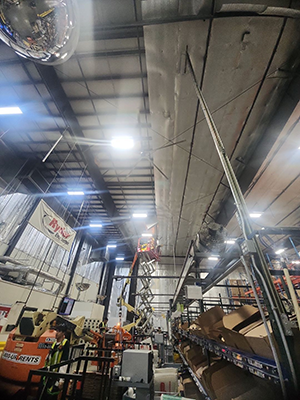
NASA engineers knew that sending humans into outer space required a different kind of insulation technology. Outer space temperatures can wildly swing from 400°F to 400°F below in a couple of hours.
Traditional insulation - foam or fiberglass - can not withstand these temperature variations. Instead, NASA turned to Reflective Insulation technology. Unlike foam or fiberglass, which delays the transfer of heat from hot to cold, Reflective Insulation reflects heat back to its source like a mirror.
This space-age technology has many practical applications on Earth, including lowering utility bills in residential homes, reflecting harmful UV rays that impact production in agriculture applications, blocking RFID electromagnetic wavelengths used inventory management systems, and classified military applications, to name a few.

Reflective Insulation and Radiant Barrier were introduced at a time when most consumers didn't have to worry about utility bills because energy was relatively inexpensive and plentiful. Were that the case today!
Heat always gravitates to cold. Traditional insulation merely delays the transfer of heat during this migration. How well it performs is measured in R-Value, the 'R' signifying a unit of resistance. The thicker the material, the higher the 'R' value, the longer it takes heat to reach cooler temperatures. Reflective Insulation has no 'R-value' because it does not delay the transfer of heat. It reflects it.
As energy costs continue to rise, so has the interest in Reflective Insulation.
Reflective Insulation and Radiant Barrier produce superior insulation products due to the structural disadvantages of foam and fiberglass.
Foam and fiberglass depend on thickness for their insulating properties and effectiveness. Both delay the transfer of heat. Unfortunately, both compress over time, making them less effective and emitting dangerous fibers into the atmosphere that can cause serious health issues to highly sensitive individuals.
One thin layer of Reflective Insulation and Radiant Barrier provides superior insulating qualities, does not rely on thickness to be effective, has no known health side effects, and never needs to be replaced.
When Reflective Insulation prevents heat from entering a structure, AC systems do not constantly kick on to constantly counteract radiant heat seeping through the attic and into the living space.

Reflective Insulation and Radiant Barrier block UV rays that degrade consumer products and adversly impacts living organisms. They also reflect destructive Electro-Magnetic and RFID wavelengths that compromise critical financial information, network security and inventory management systems. Reflective Insulation and Radiant Barrier are also utilized in classified military applications to keep soldiers and equipment from being seen by inexpensive heat-detecting scanners.
Reflective Insulation and Radiant Barrier also protect humans, plants and animals from the 'Black Globe Effect', a condition that saps strength, clouds judgement and increases the likelihood of heath-related illnesses or death. Its use reduces commodity costs in poultry, beef, swine and milk production.